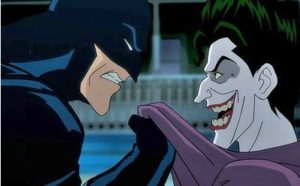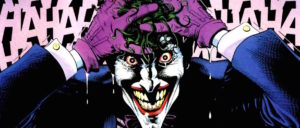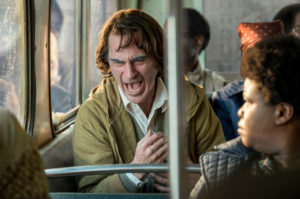The best thing about Joker, as far as I’m concerned, is that it makes Batman: The Killing Joke look far better in retrospect, if only because the latter animated feature from 2016 doesn’t try so hard to be anything other than a longer and more-risqué-than-usual Batman cartoon.
Given all the noise and clatter preceding and following Joker ‘s premiere, the controversy accompanying Killing Joke ‘s release three years ago sounds relatively quaint. It, too, presented a Joker origin story as first conceived by nonpareil comics writer Alan Moore in a 1988 graphic novel. As some of you may recall, the Joker was, as with the guy in the new movie, a struggling comedian. Only here, he’s got a pregnant wife and no prospects. So in desperate search for scratch, he agrees to aid and abet an attempted heist at a chemical plant only to be disfigured and, thus, deranged from falling into a huge vat of toxic glop.
Which turned out to nowhere near as interesting as what happened in the same movie to Batgirl, who ends up shot and paralyzed for life by the Joker, but not before a separate subplot during which she and Batman…Oh boy, do I want to spoil it for you! (Maybe I already have.) But some shocks to the system are most productively sustained in direct encounter.
Needless to say, fan boys and fan girls of all ages were scandalized, screeching, “How dare you heartless pigs do all this to Barbara Gordon?” They were likely remembering all the good times they had back in the nineties when the original Batman animated series was humming along as (since I have the floor and whether anybody cares to argue with me or not) the finest iteration of these characters on ANY sized screen.
There were also many critics who wondered whether the world really needed an R-rated animated action feature. But even if Killing Joke’s animation wasn’t exactly groundbreaking, the film was about as pure a noir product as any black-and-white early 1950s thriller with Lisabeth Scott and/or Glenn Ford. The storytelling was lean and measured, the dialogue was crisp and juicy and the vocal work was superb, most especially by Mark Hamill, whose rasping and cackling as the Joker over three decades of Batman cartoons showed more engagement, invention and audacity than anything he’s done as a on-screen actor.
Better than Joaquin Phoenix? Maybe…And so here we go…
Yes, Phoenix is brilliant in Joker, a bony wraith with hooded eyes and a heart so broken that its fragments seem to poke out of his spine. But it’s a lot of trouble to go to for a character we have no reason to connect with emotionally. Taxi Driver’s Travis Bickle was no better, the movie’s defenders insist. But Robert De Niro’s Travis had just enough charm at the outset to at least make Cybill Shepherd’s campaign worker agree to a date, even if that date was a fiasco. The movie gives neither Phoenix nor us any escape valve, any outlet for irony, wit or joy save for a few precious seconds when Phoenix’s Arthur Fleck joins an audience of entitled swells in laughing at Chapin’s blindfolded roller skating in Modern Times, a glimmer of footage evoking almost everything the movie either forgot or omitted.
Joker isn’t a movie so much as a giant boulder in the middle of Culture Gulch that’s too big to move or ignore. I suppose that’s why there’s been something about the Joker in every New York Times arts section over the last week and a half, at least. This morning’s paper had an article contending the Joker was a case study in thwarted white privilege. Sure. Fine. Whatever. Let’s by all means pump up the rhetoric about Joker being both metaphor and rallying cry for the dispossessed who would rather watch the world burn than engage in any rational effort to save it. The conceit lasts for as long as one forgets how yellow and frayed comic book pages can get over time and how fragile a vehicle they are, ultimately, for the most complex of societal dilemmas.
Still, there’s one aspect of Trump-ism I found in Joker that I haven’t yet found in any review or analysis, though it’s possible I may have missed it. The Gotham City depicted in the film looks most like a doppelganger for the New York City of the seventies with its graffiti-covered subway cars, its rampant street crime, its grimy, cluttered and combustible architecture. It has always struck me that at the core of so much of the president’s rhetoric and, for that matter, the Fox News Channel patter that both feeds and feeds off it is a perverse nostalgia for those Drop-Dead years of the Imperial City, when the hopes and dreams of reformers literally went up in smoke, white flight was at its peak and stigmatizing people-of-color for being the sole agents of their own desperate circumstances was used as fuel for a slow-building mad-as-hell conservative resurgence in the eighties. The Trumpeteers may not have dug the seventies — except for the way those years of squalor and decline made it so much easier for them to hate the sixties.
I realize that by bringing all this up that I’m adding to the same overestimation of Joker’s significance that I’m criticizing. My pallid excuse is that I’m only going along with the rest of the culture – and with the movie itself. I need to stop it here before it gets worse.
So I’m going to end this the way Killing Joke ends: with both Batman and Joker, mortal enemies and mirror images of each other’s obsessed, damaged souls, laughing together at the same dumb joke. It may not have the grandeur and oomph of Joker’s windup. But as with much else about that full-length Batman cartoon, it makes for a much more satisfying and logical conclusion – or do I mean punch line?







